Student Spotlight: Johnny Mathews at Urban Bush Women
This post is part of a series of posts by students who are part of our 21st Century Student Internship program. As part of the paid internship program, students spend several weeks with a company that’s on the UMS season.
U-M student Johnny Mathews was paired with Urban Bush Women in Summer 2017. Urban Bush Women perform in Ann Arbor on January 12, 2018.
 Photos: Group photo of all Urban Bush Women’s Student Leadership Institute (SLI) participants at the end of the Culminating Performance
Photos: Group photo of all Urban Bush Women’s Student Leadership Institute (SLI) participants at the end of the Culminating Performance
This summer, thanks to UMS’s 21st Century Artist Internship program, I was able to spend two months in New York City and had experiences that surely changed my life in known and unknown ways. I was placed within, 33-year-old dance company, Urban Bush Women (UBW), a Brooklyn-based dance company dedicated to sharing stories of the African diaspora and committed to enacting social change through dance and workshops. Most of my time with the company was focused on preparing for UBW’s Summer Leadership Institute (SLI). I assisted in administrative work to help the administrative staff as they readied all that goes into having a long workshop for over one hundred participants and staff.
This ten-day intensive program was entitled: You, Me, We – Understanding Internalized Racial Oppression and How It Manifests in Our Artistic Community. SLI consisted of dance classes that was accessible for every body–type, size, ability– to do and be involved in. These dance classes were used as ways to share different African-American dance traditions, such as the ring-shout, the Second Line, and J-Setting. Dance was just a small portion of the day, however. The first seven days of the program were focused on discussions about racism and how it manifests in our community, as well as how and what we can do as artists to help combat racism.
This first meant that we had to truly understand the systems and operations that have been in place in our country that have systematically oppressed marginalized communities. These workshops were led by an organization that works to undermine racism in communities around the country: The People’s Institute for Survival and Beyond (PISAB). I learned so much from these workshops, and my frame of reference was completely shifted with respect to how I think and talk about racism in America. I still find myself processing a lot of the information that was presented and discussed to this day.


Photos: On left, Vincent Thomas passionately leading class at SLI. On right, volunteers who helped with Black Velvet Fundraising Performance Art Event at the 14th St Y.
For the last few days of the program, the focus shifted to actually creating a culminating performance that would be presented to an audience. The way this was created was really special and something that I had never been a part of before. Instead of having one leader or creator heading the creative process, the show was created very democratically. It started with the entire community coming together and sharing what they bring to the table; whether it be music, singing, theatre, poetry, sound and light design, dance, etc. Then the performance was created by the people and allowed for everyone to showcase their best talents and abilities. Seeing the entire community come together to build upon each other’s talents was inspiring and made me think about how this can be replicated in all aspects of art making.
Though this culminating performance seemed to be the culmination of my weeks of work, there was one more part of my internship: I was able to accompany the dance company on a four-day tour to Akron, Ohio. This was a truly immersive, educational experience. I was able to follow the co-artistic directors, the company members, the company manager, and the technical director as they traversed all that comes with a quick, one-stop tour. This tour was presented by the Heinz Poll Summer Dance Festival and was composed of two performances, a master class, and a post-show talk back. Something really interesting to see was how adaptable everyone had to be on this tour.
UBW was performing excerpts from Walking with Trane and portions of their 30th Anniversary Collage, two works that the company was not currently working on. Therefore, the dancers had only one or two rehearsals together in Akron to put these works back together. Not only were they putting it together, but they were rearranging the works while we were there, with everyone adapting to the changes perfectly. I was allowed an insider’s look into how a world-class dance company interacts with a presenter, a new community, and each other.


Photos: On left, John Mathews pictured with the New York skyline from the beaches in DUMBO, Brooklyn. On right, participating in Sidra Bell’s Summer Module 2017.
I grew so much as a person by being an intern with UBW. Not only from all the work I put in for the company and the insights I gained, but also because I was able to live in New York City for two months and was afforded opportunities that I would never have been able to have otherwise. While I was in the city, I attended Sidra Bell’s Summer Module, a week-long dance intensive that connected me with a community of New York based dancers; I saw so many different kinds of performances, such as Dearest Home by Abraham in Motion, Onegin by American Ballet Theatre, Hamilton, and many more; I assisted Shamel Pitts and Mirelle Martins in a fundraising event for their world tour of Black Velvet; and I was simply able to feel settled in while living in New York City. I had a summer immersed in all facets of the art-making process and am so grateful to UMS for the opportunity.
See Urban Bush Women on January 12, 2018.
Student Spotlight: On the Road with Trisha Brown
Editor’s note: During the summer of 2014, UMS launched a new 21st Century Artist Internship program. Four students interned for a minimum of five weeks with a dance, theater, or music ensemble part of our 2014-2015 season. Hillary Kooistra is one of these students. She spent the summer in New York and on the road with the Trisha Brown Dance Company.
Below she recounts her travels with the company. The Trisha Brown Dance Company will perform Proscenium Works, 1979-2011 at the Power Center on February 21-22.
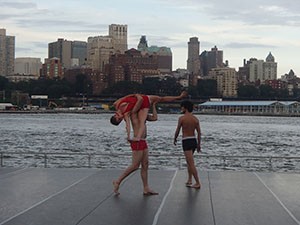
TBDC Dancers Tara Lorenzen, Nick Strafaccia, and Olsi Gjeci perform “I’m going to toss my arms — if you catch them they’re yours” on Pier 15 at the South Street Seaport in NYC.
As an embedded intern with the Trisha Brown Dance Company (TBDC), I worked alongside TBDC administrators and artistic directors, observed the company in rehearsals, befriended the dancers, learned repertory and improvisation/ composition techniques from TBDC alumni, and watched many, many performances. During my internship, I accompanied the dancers and TBDC artistic staff on two trips. This gave me a taste of life on the road for a dancer in an international touring company and allowed me to develop a deep understanding of the diverse performance programs that the Trisha Brown Dance Company presents.
The first stop on my personal tour with TBDC was Annandale-on-Hudson, New York, where the company was invited to perform selections from its Proscenium Works, 1979-2011 tour (the final tour of Trisha’s repertory works specifically choreographed for the stage, coming to Ann Arbor in February). After a NYC performance of “I’m going to toss my arms, if you catch them they’re yours” (fondly referred to by the company as “Toss”), I joined the company in a 15-passenger van headed toward Bard College. Though I was new to the touring artist lifestyle, I quickly learned that this pace is typical for the dancers. In one day, they danced on a pier overlooking the East River, drove upstate from New York City, and prepared for the next round of performances!
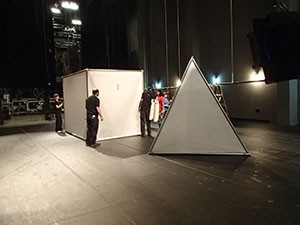
Load-in of Robert Rauschenberg’s set piece for “Set and Reset” prior to the company’s Bard SummerScape performance.
We arrived at Bard late that night. Throughout the weekend, I found myself enchanted by little details of tour life, as mundane as they may seem. I loved the trips to the grocery store to stock up on weekend meal essentials, the hospitality provided by the presenter, and the pre-rehearsal or performance rituals of each individual dancer before they all came together as a group; these helped me recognize touring as a realistic and obtainable aspect of a professional dance career, as opposed to something far-fetched and imaginative.
Even more exciting for me was the opportunity to watch the program in technical rehearsal and performances. The company presented “I’m going to toss my arms — if you catch them they’re yours,” “Set and Reset,” and “If You Couldn’t See Me.” They will bring the latter two to Ann Arbor. Seeing Diane Madden, co-associate artistic director of the company, lead the dancers in onstage rehearsals was like getting a sneak peek at the man behind the curtain before the grand unveiling.
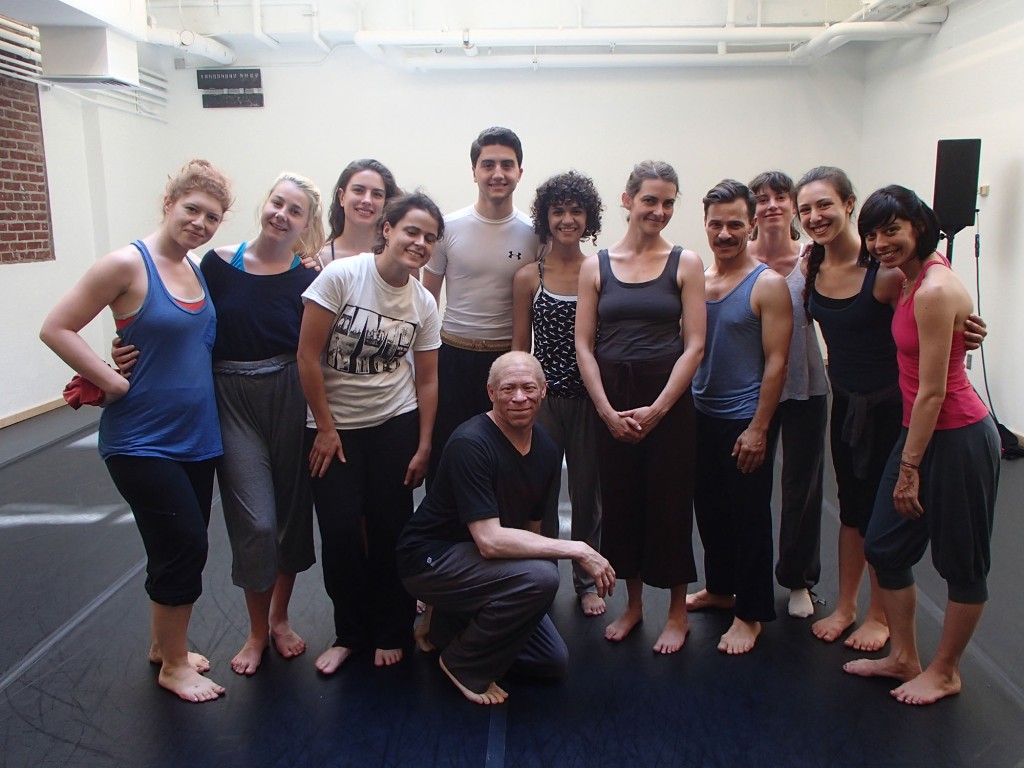
TBDC Summer Intensive students with Company alumnus Keith Thompson.
My impression of the works was further enhanced when I watched them in performance with full costumes, lights, and set. Trisha valued the visual design elements of dances as much as she did the movement — collaborating frequently with artists such as Robert Rauschenberg and Donald Judd — and her choreography breathed a new light with the integration of additional production elements. I saw the program three times, and each time I noticed something new, but also recognized familiar moments or images. I’ve grown to admire this about Trisha’s work: her dances have multiple layers, but follow a cohesive line that runs parallel to the surprising twists and turns.
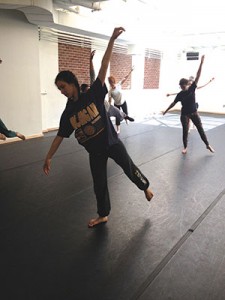
Dancing a part of “Newark” at the TBDC Summer Intensive.
After our weekend at Bard, I parted ways with the company. I returned to New York to serve as the on-site coordinator for the TBDC Summer Intensive, a three-week workshop that offered up to six hours of technique, repertory, and composition classes each day. I acted as a point of reference for students and teachers and was also able to dance! Classes allowed me to further explore the works I had grown to know intimately as an audience member, and to embody the movement that I only saw and read about up until this point. Composition/improvisation class revealed the techniques behind choreographic concepts I had observed in Trisha’s work and allowed me to apply them to my own dance making. Some of what I learned will surely find its way into the work I create for my Senior BFA Concert this coming April!
In August, I reunited with the company for my second tour experience of the summer, a performance of Trisha’s Early Works at the Lynden Sculpture Garden in Milwaukee, WI. Before she began choreographing larger works such as “Set and Reset” for the proscenium stage, Trisha concentrated on shorter, site-adaptive dances for alternative venues such as museums, rooftops, and parks. The company performs these works for events throughout NYC and international tour venues and will continue to concentrate on these types of performances after the conclusion of Proscenium Works, 1979-2011.
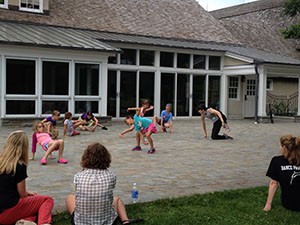
TBDC dancer Tamara Riewe leads young members of Lynden’s summer camp in demonstrating poses inspired by the sculptures in the garden.
This trip to Milwaukee marked my first foray into site work, and I quickly learned how much extra effort must go into presenting dance in any area other than a stage. We spent the first day at the Garden traveling from spot to spot, considering which dances would work best in front of which sculptures, identifying the strongest vantage points, and mapping a path for the audience to travel between locations. Since all the company members were not present for the initial site visit, I often assumed the role of a stand-in to help the team visualize dances in different locations. I was able to try some of Trisha’s choreography and tasks on site, doing her signature “Group Primary Accumulation” while floating on a raft in the middle of a pond and walking down the side of a tree for “Spiral.”
Trisha’s Early Works are full of these fun tasks and were an absolute blast to watch in performance. In one work titled “Sticks,“ dancers moved through a series of postures while balancing long, wooden sticks on their heads. This lighthearted performance atmosphere contributed to the informal relationship established between the dancers and audience. Throughout the performance, the dancers interacted with us, acknowledging when something wasn’t working and inviting us to join in on their fun. This, I discovered, was a delightful difference between the Early Works and Proscenium Works programs, the latter of which demonstrates a traditional separation between performers and audience.

TBDC members perform Sticks at the Lynden Sculpture Garden in Milwaukee, Wisconsin.
Seeing the Early Works really sparked my interest in dance for alternative spaces, which I’ve been exploring since I’ve returned to Michigan. This marks one of the many ways that my travels with the company influenced my impressions of Trisha’s work and view of the dance field. I grew leaps and bounds throughout the summer, but my experience would not have been complete without the opportunity to climb in a van with 11 professional dancers or to walk down the side of a tree in front of the company’s associate artistic director. I began my rich and unique experience as an intern “embedded” with the company, but emerged as a knowledgeable, conversant member of the TBDC family.
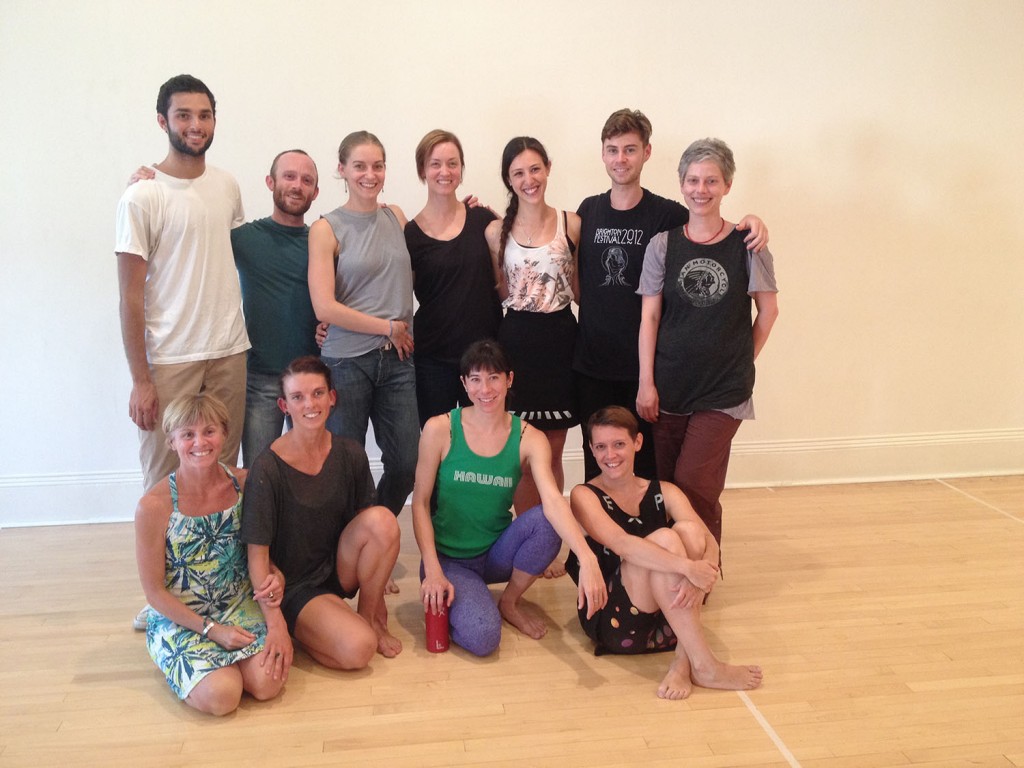
Smiling with Carolyn Lucas, Diane Madden, and the TBDC company members. Thank you for a wonderful summer!


